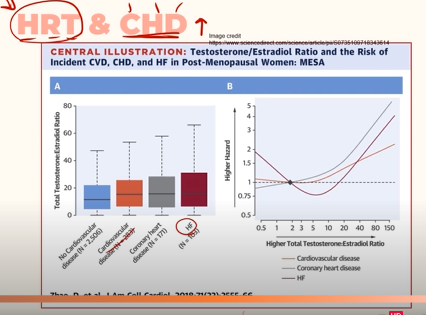Reproduction
1/52
There's no tags or description
Looks like no tags are added yet.
Name | Mastery | Learn | Test | Matching | Spaced |
|---|
No study sessions yet.
53 Terms
What is the difference between Sexual & Asexual Reproduction?
Sexual Reproduction:
Involves two parents, requires the fusion of gametes, and creates genetically unique offspring.
Asexual Reproduction:
Only requires only one parent, does not involve gametes, and produces genetically identical offspring (clones).
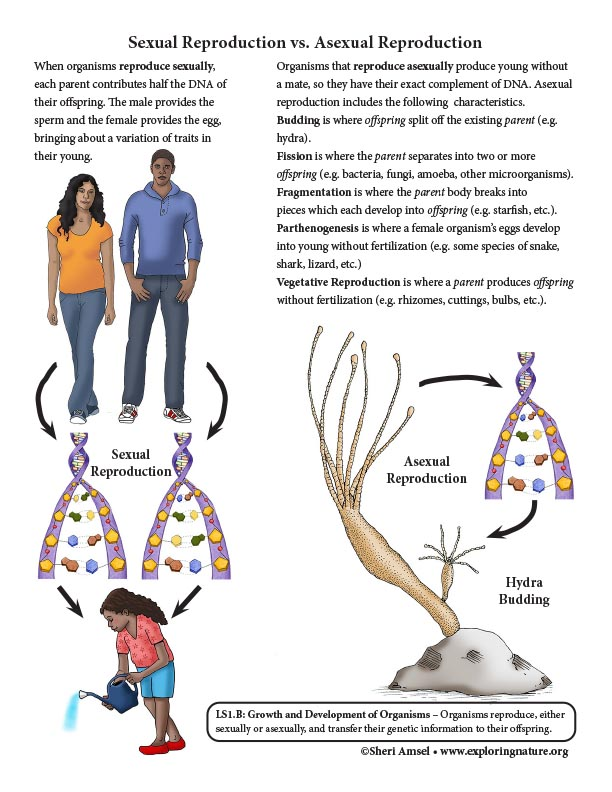
What are Gametes? Describe the characteristics of Gametes in Humans/Animals vs In Plants;
Gametes are sex cells that are haploid, meaning they only contain half of the normal chromosome count (23 chromosomes as opposed to 46 chromosomes)
Gametes in Humans + Animals:
Sperm = Male Gamete
Egg = Female Gamete
Each contain 23 Chromosomes
When Sperm & Egg fuse together, they form a zygote, which is diploid (46 chromosomes)
Gametes in Plants:
Pollen = Male Gamete
Ovum = Female Gamete
Each contain 23 Chromosomes
When Pollen & Ovules fuse together, they form a seed embryo
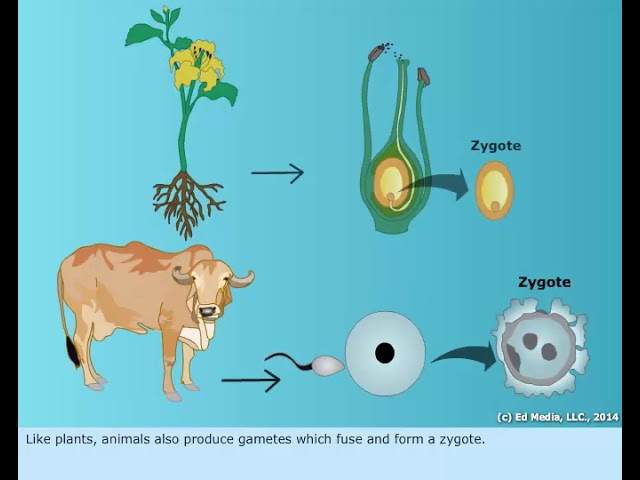
What are the Advantages & Disadvantages of Sexual & Asexual Reproduction?
Sexual Reproduction:
High genetic variation, because unique offspring are produced
Slow rate of reproduction
Limited number of offspring
Strong adaptability skills, can adapt very well to the environment
Are Highly resistant to disease, some offspring may survive
High energy requirements, to find a mate and for fertilization to occur
Asexual Reproduction:
Low genetic variation, genetically identical offspring are produced
Fast rate of reproduction
Unlimited number of offspring
Poor adaptability skills, very sensitive to the environment
Have low resistance for disease, because the entire population is generally affected
Low energy requirements, because there is no need to find a mate
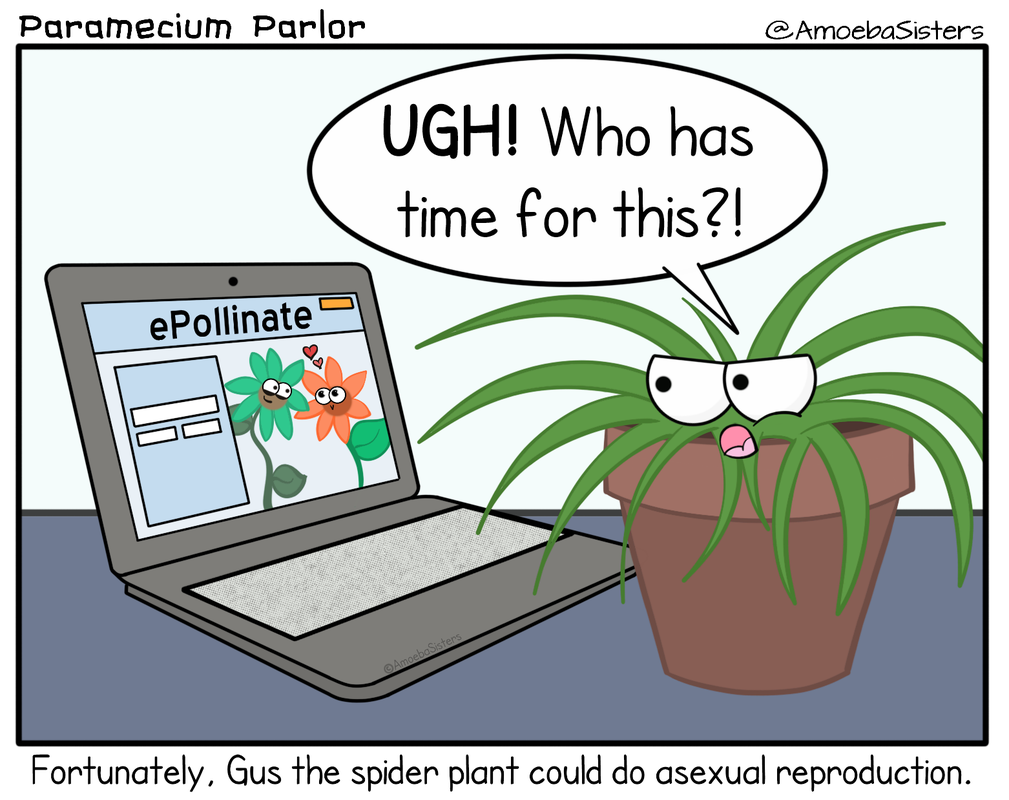
What is meiosis? What about meiosis contributes to genetic variation?
Meiosis is a type of cell division that produces haploid gametes (sex cells) (which are haploid) from diploid cells.
Processes in meiosis that contribute to genetic variation are:
Crossing over → Chromosomes exchange alleles, shuffling genetic material.
Independent assortment → The random distribution of chromosomes into gametes to create different combinations.
Random fertilization → Any sperm can fuse with any egg, creating millions of possible genetic combinations.
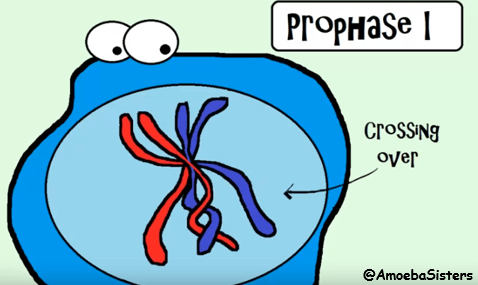
Where does meiosis occur in animal/humans as well as plants?
Meiosis occurs in the reproductive organs, because it’s trying to produce new sex cells;
In humans, Meiosis occurs in the:
Testes (males) → Produces sperm continuously.
Ovaries (females) → Releases one egg per menstrual cycle.
In plants, Meiosis occurs in the:
Anthers (male) → Produces pollen
Ovaries (female) → Produces ovules
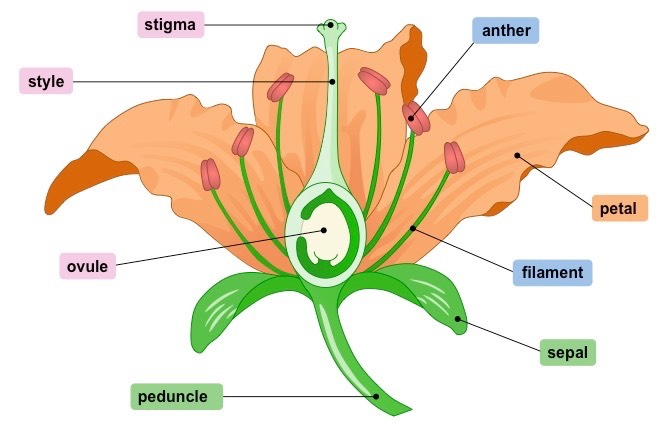
What’s the difference between male and female gametes?
Sperm
Is very small (only 45 micrometers)
Has a Head & Flagella
Is capable of locomotion using its flagella, which propels it forward
Produces millions per day
Egg
Size = large (0.15 mm)
Is round and jelly-coated
Is not capable of moving
Only one is released per month
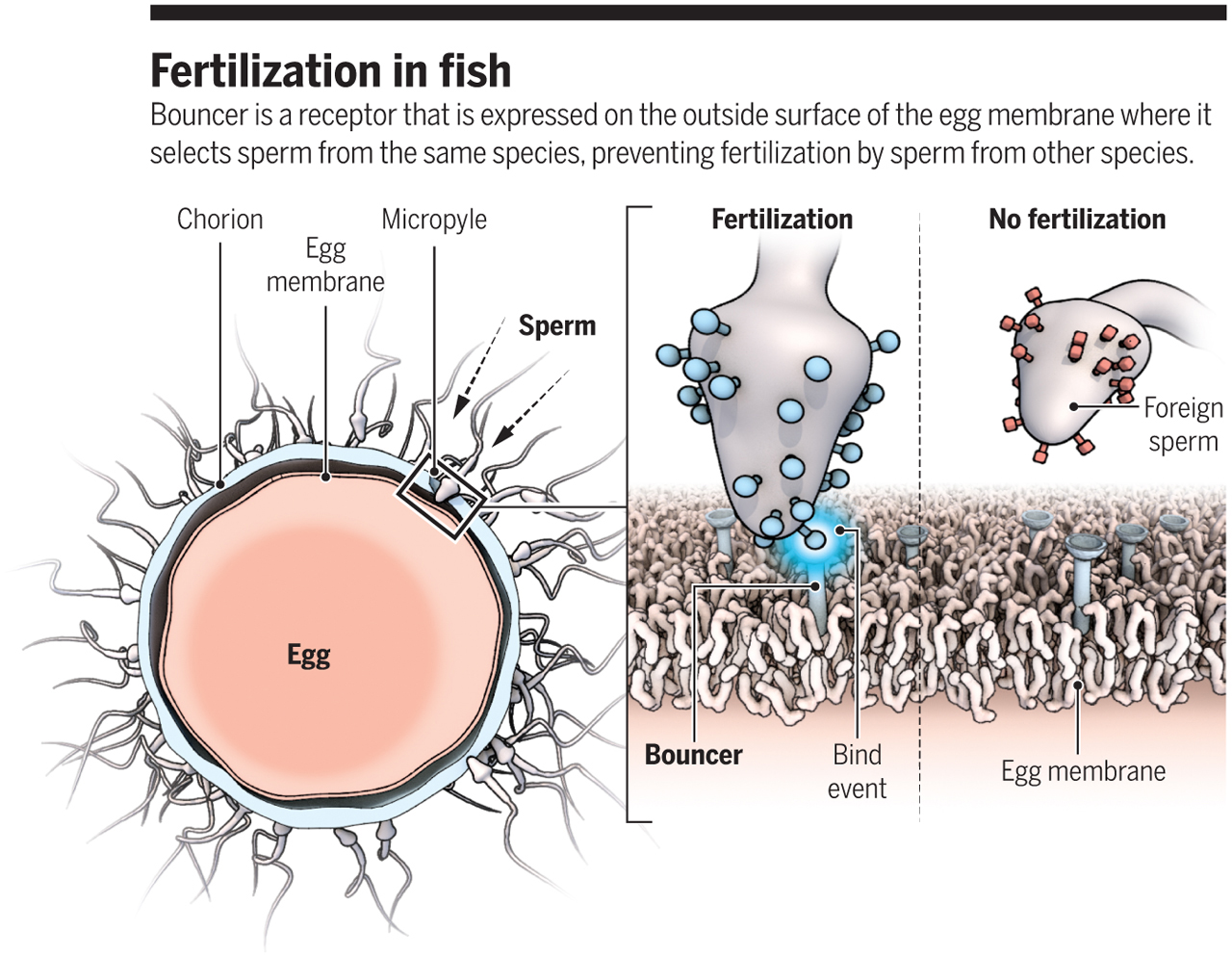
Here’s another image to go along with the terms:
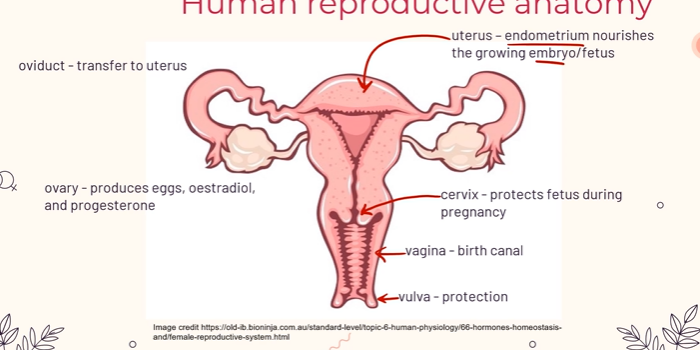
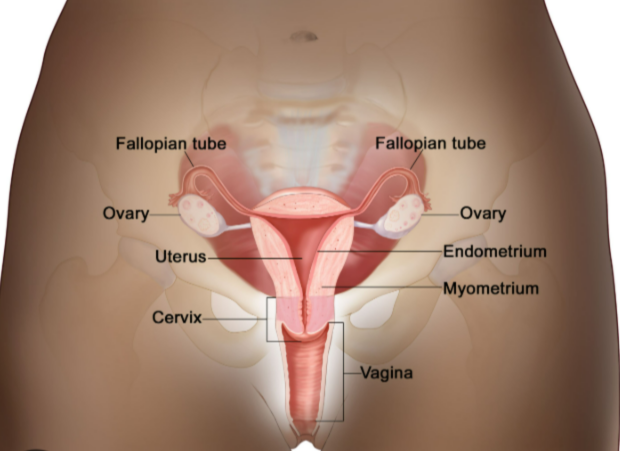
Draw and label the front and side view of the female reproductive system; describing the different parts:
Oviduct (Fallopian Tube) = Connects the ovary to the uterus, and helps push the ovum (the egg cell) released during ovulation to the uterus.
Ovary = Found in between the pelvis, releases hormones like estrogen and progesterone, which regulate the menstrual cycle (think of the ultrasound examination)
Uterus = A muscular organ with a soft lining where the fertilized egg implants and develops into a fetus
Cervix = A muscular ring at the lower end of the uterus; It stays closed during pregnancy to keep the developing fetus in place, but dilates after childbirth.
Vagina = A muscular tube that leads inside the body, and receives sperm during intercourse. The vagina is the birth canal during childbirth
Vulva = Includes the labia, clitoris, and hymen, which protect the internal reproductive organs and are involved in sensations during sexual intercourse
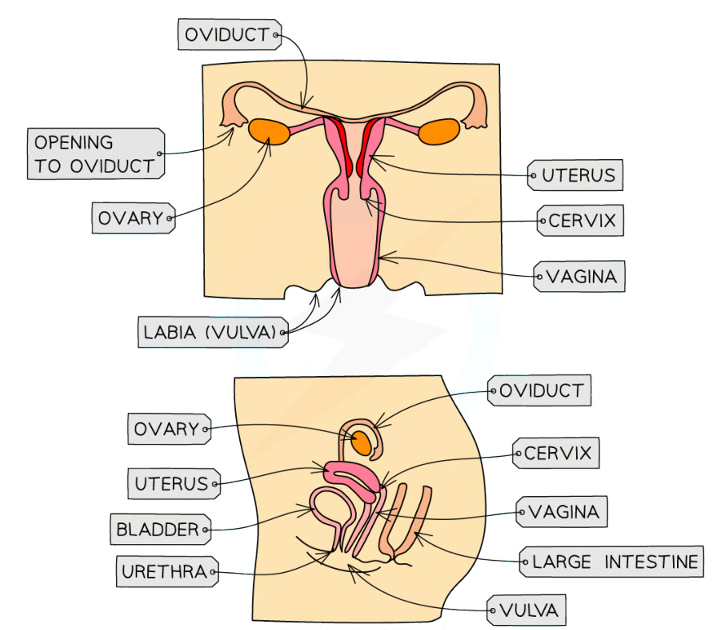
Draw and label the front and side view of the male reproductive system; describing the different parts:
Sperm Duct = Transports sperm from the testes to the urethra
Testis = Produces sperm cells (male gametes) and testosterone, the hormone that regulates male characteristics
Scrotum = A sac that holds the testes, and maintains a temperature slightly below body temperature to keep the sperm alive/surviving
Prostate Gland & Seminal vesicles = Produces semen, the fluid that nourishes and creates sperm
Penis = Passes urine and semen out of the body and into the vagina during intercourse
Urethra = Carries urine or semen out of the body; It is controlled by a muscular ring that prevents the urine + semen from mixing together
Epididymis = Coiled tubes that store the sperm until ejaculation
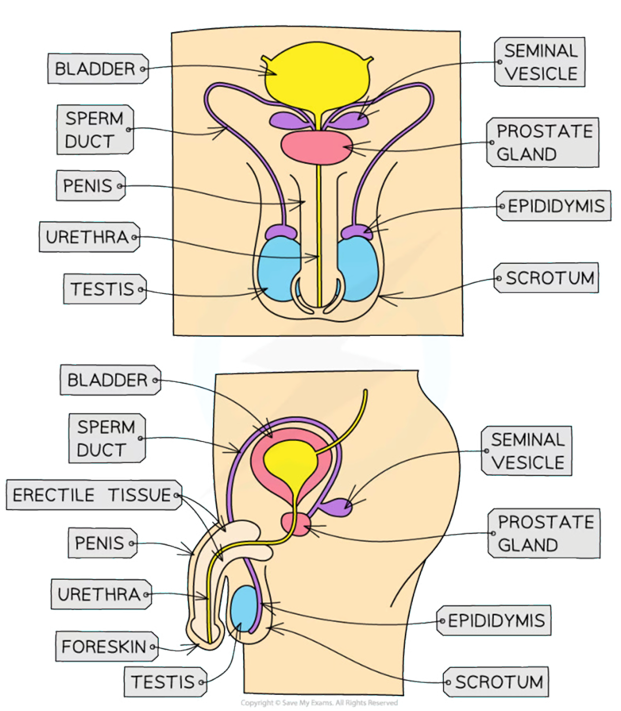
How long is the menstrual cycle? What is the purpose of the menstrual cycle? What does the menstrual cycle generally involve?
The menstrual cycle is 28 days long!!
The job of the menstrual cycle is to prepare the body for a potential pregnancy; It involves hormonal changes that regulate ovulation (the release of the ovum from the ovaries), uterine lining development, and menstruation
What is another name for oestrogen? What is a follicle?
Oestradiol
A follicle is a small, fluid filled sac in the ovary that contains a developing egg, known as an oocyte.

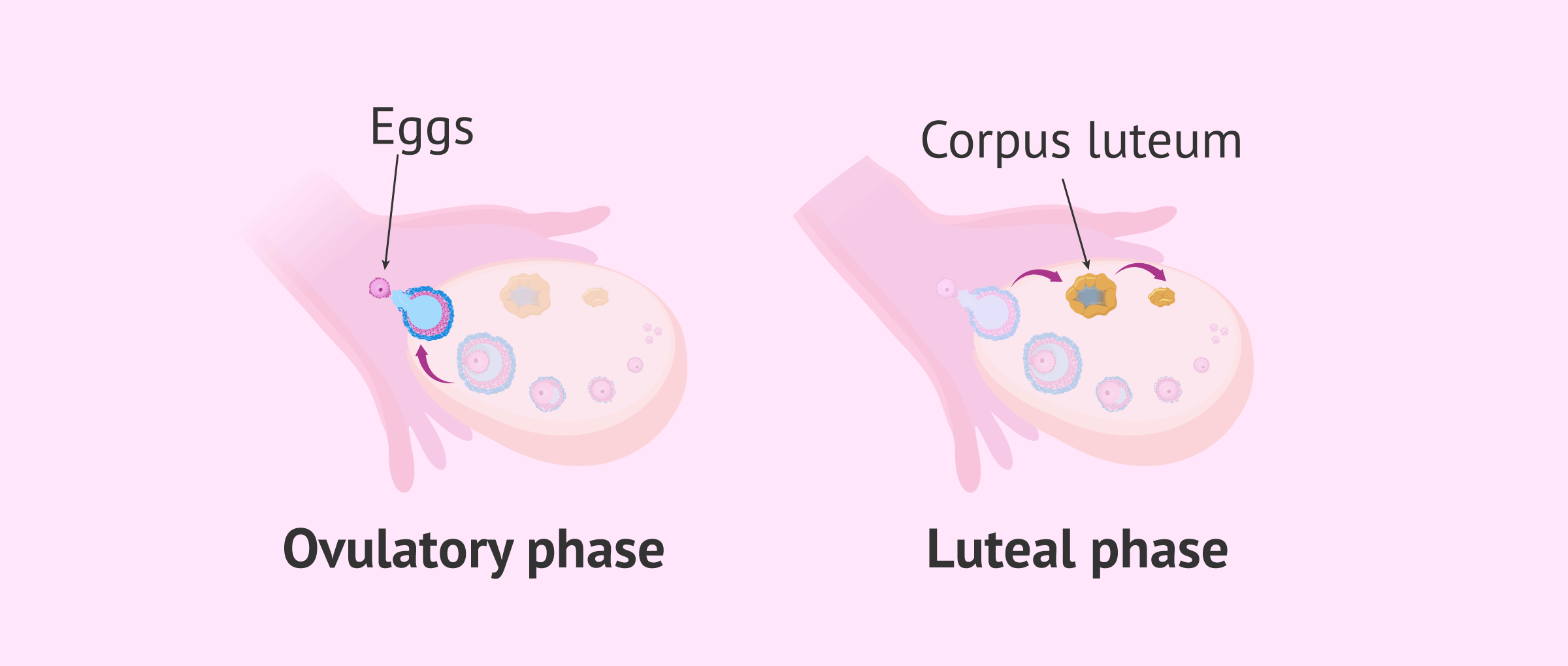
What happens in the 28 days of the menstrual cycle?
Menstruation (Day 1-5):
If an egg has not been fertilized, it naturally disintegrates. Low levels of estrogen and progesterone cause the uterine lining to break down, and it is shed in the form of menstrual blood along with the unfertilized egg which is released through the vagina.
Follicular Phase (Day 1-13)
The pituitary gland produces rising levels of follicle stimulating hormone (FSH), which stimulates the ovaries to develop several follicles, each one containing an egg; but one follicle will reach maturity. Towards the end of this phase, the ovaries secrete increasing levels of estrogen, which cause the uterine lining to thicken in preparation for a potential fertilized egg.
Ovulatory Phase (Day 14)
The pituitary gland releases a surge of Luteinizing hormone on Day 14 of the cycle, which causes the mature follicle to burst, releasing the egg into the fallopian tube. Then the egg starts to travel down the fallopian tube down into the uterus; This is the time when a woman is most likely to get pregnant. Note: eggs get fertilized in the fallopian tube.
Luteal Phase (15-28)
After releasing the egg, the ruptured follicle develops into a structure called the corpus luteum, which starts secreting increasing amounts of progesterone. Progesterone causes the uterine lining to further thicken and prepare for a possible pregnancy
If the egg is fertilized on its journey through the fallopian tube, then it starts to form a small ball of cells called the zygote, which will eventually implant itself in the uterus, where it will become a fetus. If the egg is fertilized, the placenta (which forms as part of the uterus during implantation) starts producing HCG (human gonadotropin hormone) that maintains the corpus luteum and continues the secretion of progesterone (for further thickening of the uterine lining).
If the egg is not fertilized, then the corpus luteum breaks down after about 14 days, and estrogen and progesterone levels drop. This causes the endometrial/uterine lining to break down and shed through menstrual blood that leaves through the vagina, restarting the cycle.
Mensturation, Follicular Phase, Ovulatory Phase, Luteal Phase
FELP!! (Follicle stimulating hormone, estrogen, luteinizing hormone, progesterone)(this is the order in which the hormones peak) (estrogen and progesterone are both produced in the ovaries, while FSH and LH are produced in the anterior pituitary)
This wall gets built up and broken down 12 times a year; So we tear down and rebuild the uterine lining over and over, this actually helps save energy
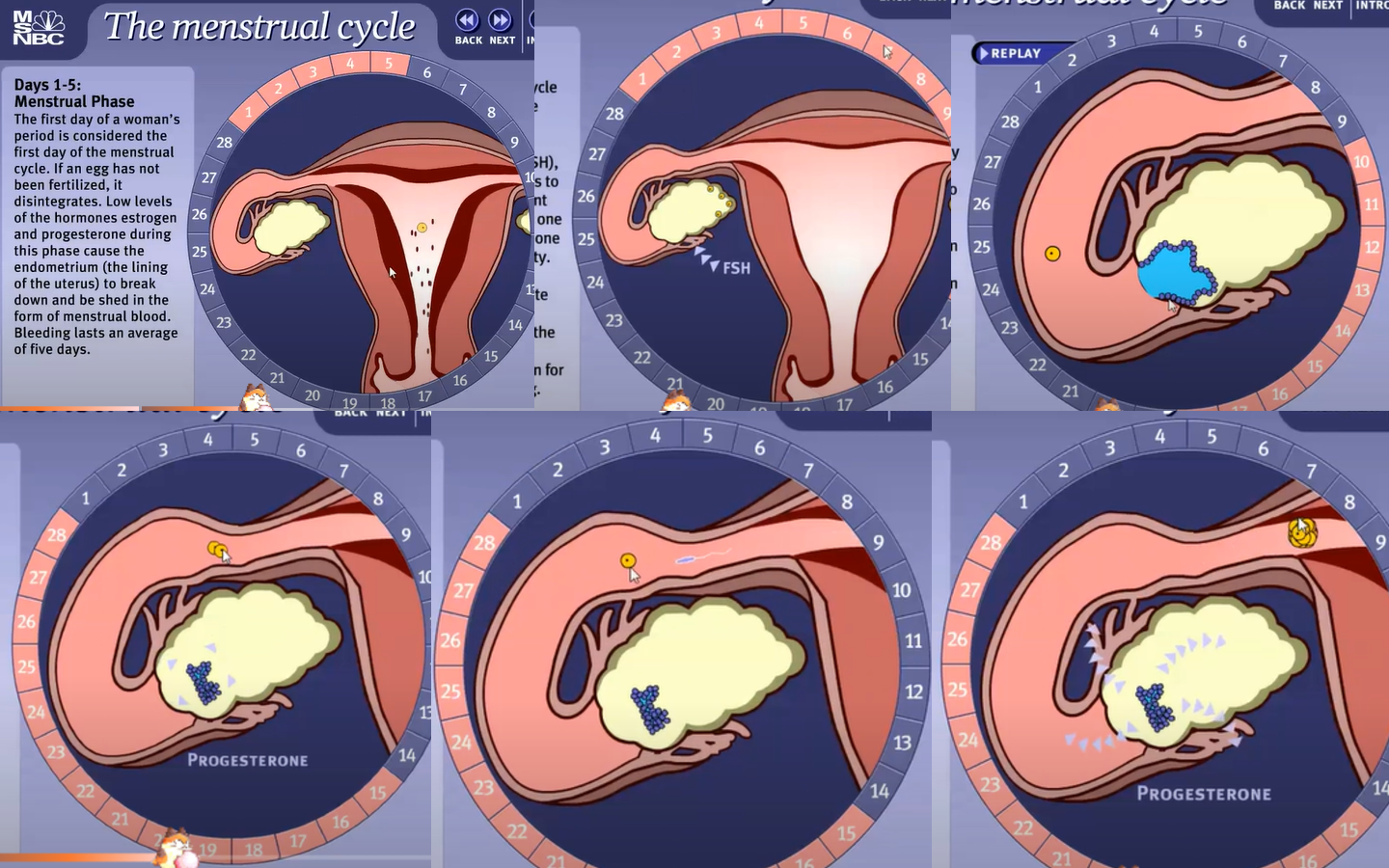
Can you describe the function of FSH, LH, Oestrogen, & Progesterone? What are the differences between them and where they are secreted?
FELP
Follicle Stimulating Hormone = stimulates the follicle in the ovary to continue developing, and it also stimulates the ovaries to secrete estrogen
Estrogen = Estrogen is secreted to help thicken the uterine lining in preparation for a potential pregnancy
Luteinizing Hormone = Stimulates the mature follicle to burst, releasing the egg into the fallopian tube, at which point it can be fertilized. It also stimulates the ruptured follicle to be converted into the corpus luteum, which starts to secrete progesterone, which further thickens the uterine lining.
Progesterone = continues to thicken the uterine lining and maintain the uterine lining if a pregnancy does happen. However, progesterone levels drop dramatically at the end of the menstrual cycle if fertilization does not occur

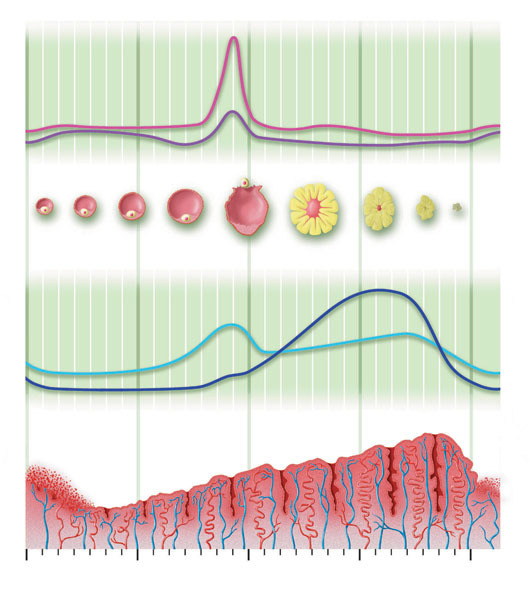
Label the following lines on this graph; What does it mean if you see progesterone levels fall at the end?
Estrogen and progesterone are always the ones at the bottom
It means that the lady didn’t get pregnant

Can you give some examples of positive feedback in the menstrual cycle?
Positive Feedback:
OVULATORY PHASE
When estrogen is released from the ovaries, causing the uterine lining to thicken, it also stimulates luteinizing hormone to be released by the pituitary gland, which causes the mature follicle to be converted into the corpus luteum, and to release the mature egg down the fallopian tube; When the remaining follicle becomes the corpus luteum, it also secretes more estrogen (besides progesterone)
Negative feedback:
LUTEAL PHASE
Luteinizing hormone stimulates the mature follicle to release the egg, converting it into the corpus luteum, and causing it to release progesterone as well. Progesterone helps thicken and maintain the uterine lining, but it also inhibits LH and FSH, preventing any additional eggs from being released. And if the egg doesn’t get fertilized, then progesterone levels drop even further and the cycle restarts.
What happens in IVF (in-vitro fertilization)
The mother is given drugs that block FSH and LH to temporarily stop the menstrual cycle, so that it can be controlled using artificial hormone injections.
Large doses of LH and FSH are used to stimulate multiple follicles in the ovaries to mature, and eventually burst to release MULTIPLE mature eggs into the fallopian tube (through a process called superovulation).
The eggs are then collected through follicular aspiration and fertilized in a lab using sperm. The fertilized eggs develop into embryos, and one or more than one are implanted into the uterus; After that, the zygote should develop normally, as if it had been normally fertilized.
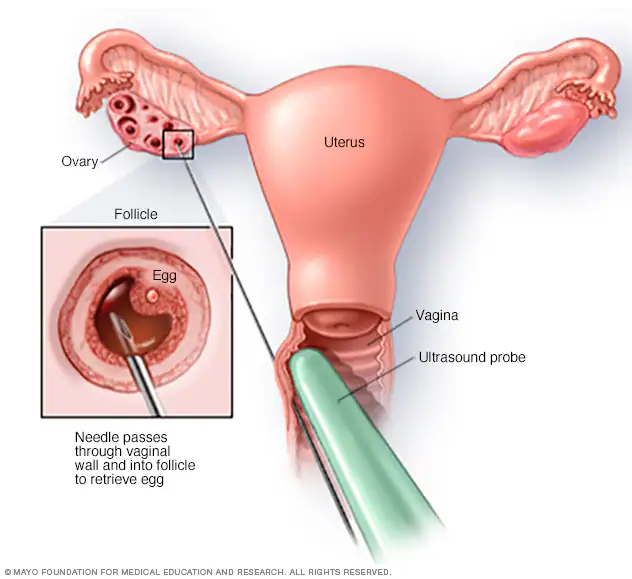
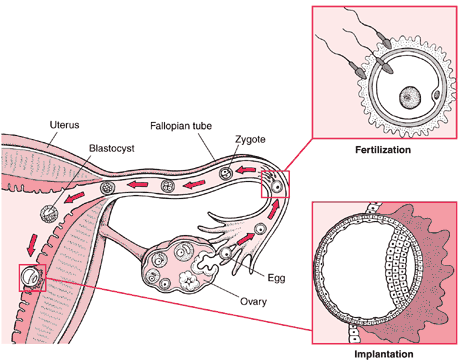
How does the process of fertilization happen?
Sperm starts to swim up to the fallopian tube, where the egg is (the egg here is known as the Secondary Oocyte); Only about 0.1% of sperm make it here
First, sperm breaks through the corona radiata, the follicle cells of the egg, then it binds to the zona pellucida, a jelly-like layer made of glycoproteins that surrounds the plasma membrane of the egg cell.
The acrosome head of the sperm contains digestive enzymes that break down the glycoproteins of the zona pellucida, and allow the sperm to fuse together with the plasma membrane of the egg.
Eventually, the fusion of these two membranes creates an opening that allows the nucleus of the sperm to enter the egg. Since both the egg and the sperm are haploid (23 chromosomes each), when they combine, they form a diploid cell called a zygote. The zygote eventually goes on to form a hollow ball of cells called the blastocyst, and implants in the uterus, which is what starts pregnancy.
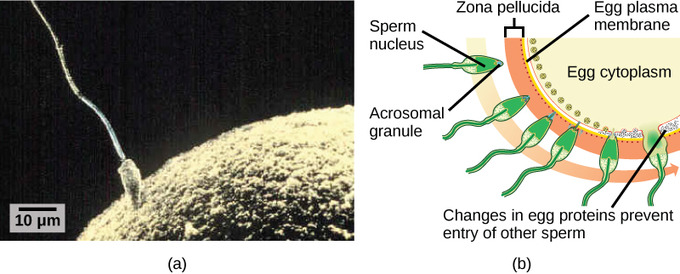
What is the role of the zona pellucida?
It helps prevent polyspermy from happening, allowing only one sperm cell to enter at once,
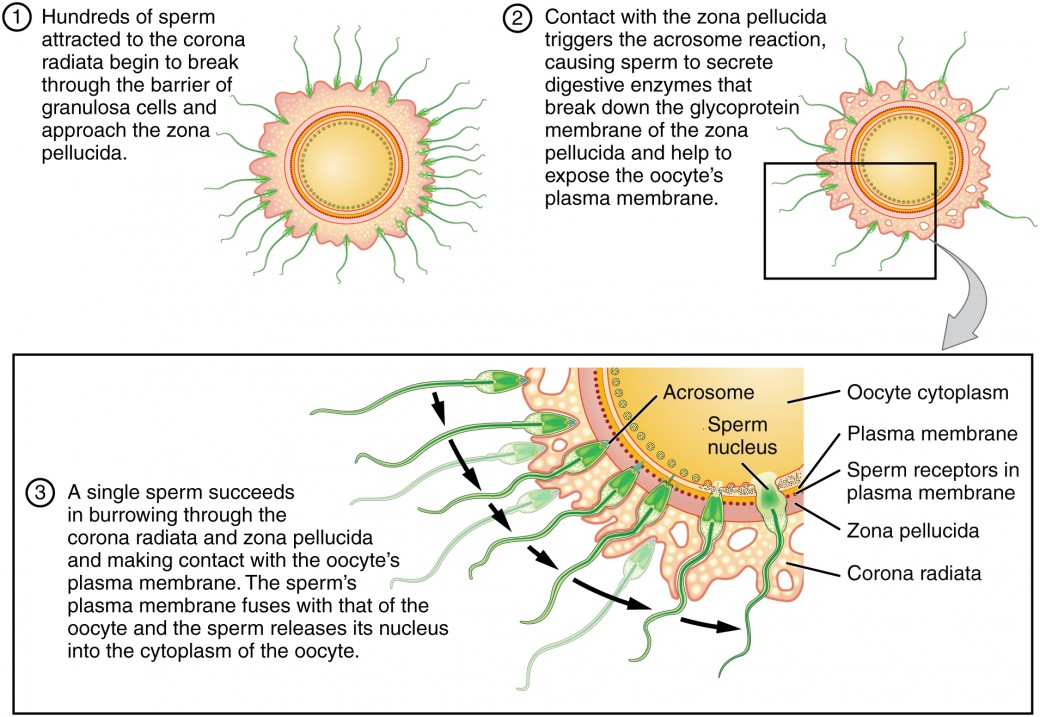
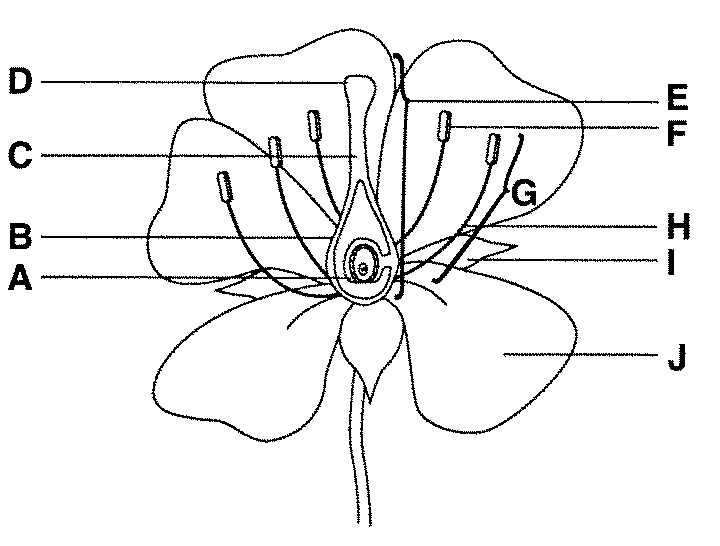
Label the following diagram of a flower, and describe the function of each part
Petals = attract pollinators
Stamen = the male part of the flower that consists of the anther and the filament.
The anther is where pollen is produced, and inside the pollen grains are sperm cells;
The filament holds the anther up high so that when a pollinator comes along, the pollen grains will stick to the pollinator
The Pistil (aka Carpel) - the female part of the flower, contains the stigma, the style, the ovary, and the ovule.
The stigma is sticky, so that the pollen grains will actually stick to it;
The style holds the stigma up so that the pollinators carrying the pollen grains will actually reach it.
In the ovary, there are ovules, where eggs are produced, and fertilization will occur, and seeds will eventually develop.
Sepals = leaves that protect the flower as its growing
Stem = sometimes contains nectaries, that secrete nectar outside of the flower
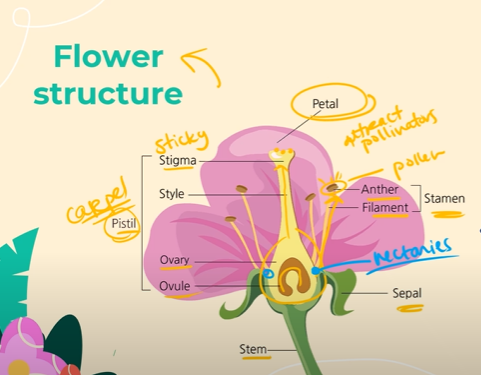
Where are the male and female gametes of a plant produced? What are these gametes called?
Male gametes are the pollen, and the pollen grains are produced in the anther, and inside the pollen grains are where the sperm is found.
Inside the pollen cells,
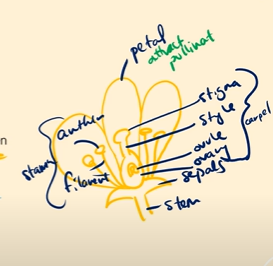
How are mature pollen grains produced in the Anther of the flower? What’s important about the end result of this process?
Inside the anther, a diploid (46 chromosome) mother cell undergoes meiosis I and meiosis II, to form four haploid (23 chromosome) pollen grains (the gametes)
Then, each of these haploid pollen grains goes through MITOSIS, leaving the pollen grains haploid, but instead, creating 2 nuclei in each haploid pollen grain cell!
The point of having these 2 nuclei is that they are going to serve different functions; One of the nuclei is going to be a pollen tube nucleus, that will develop into an elongated pollen tube, while the other nuclei is going to be the generative nucleus, which is going to be involved in fertilization.
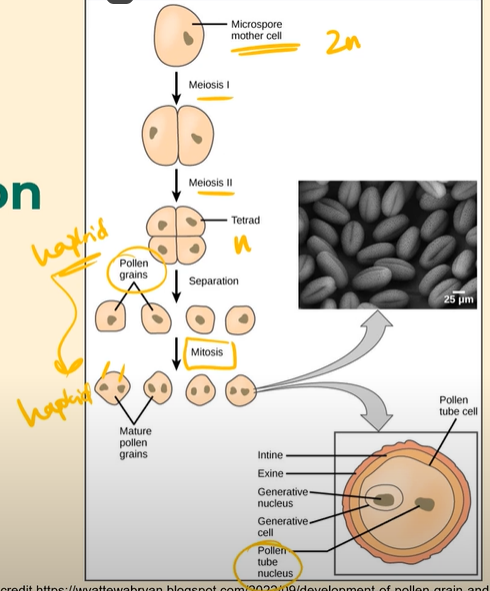
How are mature ovules produced in the female parts of the flower? Where is it produced?
Ovules are specifically produced in the ovule inside the ovary of the flower (which is a part of the overarching carpel/pistil). Inside the ovule is the egg cell (which is the actual gamete)
Inside the ovule, a large diploid cell goes through meiosis to produce four haploid egg cells, But only one of these egg cells actually survives and continues to divide by mitosis to form female gametes.
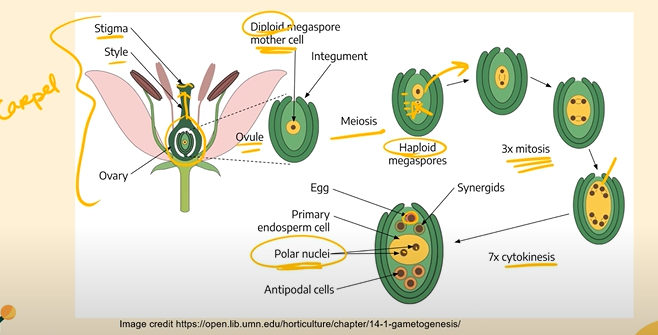
Which comes first, pollination or fertilization?
Pollination happens BEFORE fertilization
What is pollination? Describes how it works?
Pollination is the transfer of pollen from anther to stigma! Often done with the help of a pollinator, like a bee.
When a bee goes to drink nectar from a flower, some of the pollen from the anther sticks to the bee. As the bee travels to another flower or plant of the same type, pollen on the bee sticks to the stigma of a flower on the other plant!
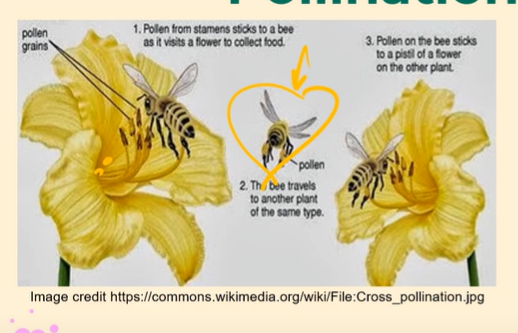
What happens in the fertilization of a flower?
The pollen grain that got stuck to the sticky stigma is going to start growing a pollen tube.
The pollen tube grows with the help of the genes found inside the pollen grain.
As the pollen tube grows, the other nucleus of the pollen grain, the generative nucleus, is going to travel down the pollen tube.
As the generative nucleus travels down the pollen tube, the generative cell goes through mitosis ONE MORE TIME, which creates 2 sperm cells inside the pollen tube.
The pollen tube continues growing down until it reaches one of the ovaries.
Inside of the ovule, the generative nucleus fuses together with the nucleus of the egg cell, forming a diploid zygote. The zygote then divides through mitosis to form an embryo, which goes on to become a seed.
Meanwhile, the second sperm, instead of fertilizing another egg, combines with the two polar nuclei found inside the ovule, forming a triploid endosperm!
Endosperm is the food of the developing seed; because of this, the ovary ends up becoming the fruit that we eat.
So while the OVULE develops into the seed, the OVARY develops into the fruit.

What are some of the features of insect-pollinated flowers?
They have very LARGE and BRIGHTLY COLORED petals that give off a scent to attract pollinators.
The Pollen Grains are large and spiky so that they can stick to the bodies of the bees and other pollinators
They have nectaries on their stems which secretes nectar, a type of sugar water. But these nectaries are found pretty deep, somewhere near the bottom of the step, which encourages pollinators to really stick their bodies into the pollen grains so the grains can stick to their bodies.
They have large, sticky Stigmas that help collect the pollen grains from other flowers
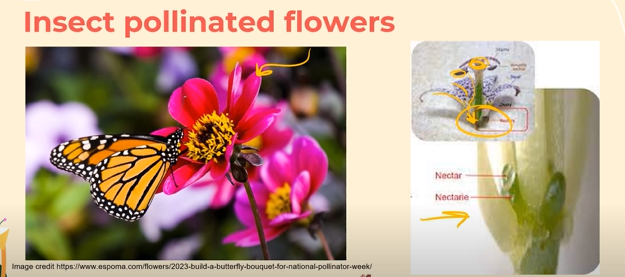
What’s the difference between self-pollination and cross-pollination? What are some of the advantages and disadvantages of each? Which one is more common and why?
Self-pollination is when pollen grains are transported to the sticky stigma of the very same plant;
While cross-pollination is when pollen grains are transported from the anther of one plant to the sticky stigma of another plant.
Self-pollination is a great method to use when you are a plant that is totally isolated from other plants, however it is not going to lead to any genetic diversity, because this is essentially inbreeding.
So while cross-pollination requires other plants to be around, it also leads to more genetic diversity, and is more beneficial to a plant species’ survival, especially when it comes to resistance. Because of this, plants have developed more adaptations for cross-pollination, because it benefits the species more.
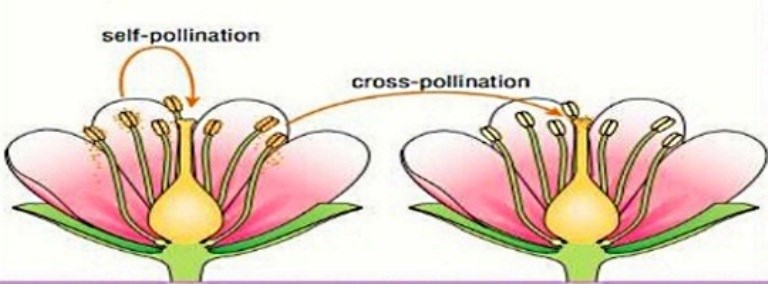
What are some of the simpler adaptations that plants have for cross-pollination?
Many of the adaptations are the same as the ones discussed earlier; about plants having large colorful, scented petals to attract pollinators, nectarines in their stems which secrete nectar (also to entice pollinators), and sticky stigmas for the pollen to stick to, as well as spiky pollen grains so that the pollen will stick to the pollinator.
However, some plants have separate flowers for their male parts (the stamen containing the anther, filament, and sepal) and their female parts (pistils containing the ovary, ovule, and stigma), on the same plant. For example, zucchinis have separate male and female flowers on the same plant
Alternately, some plants have separate flowers for their male and female parts on two totally different plants! One example of this is the ginkgo biloba tree, which has whole entire trees only containing flowers with female parts, and whole entire trees only containing flowers with male parts
Some plants also have anthers and stigmas that mature at different times
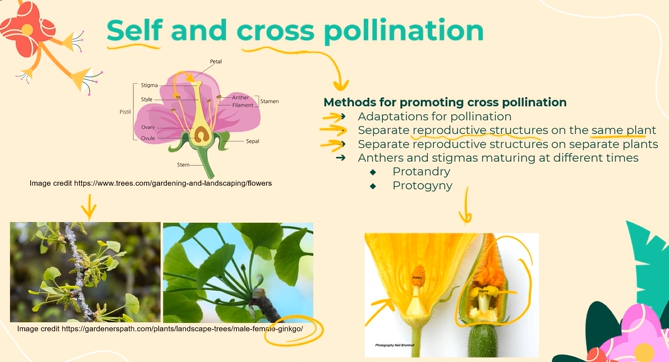
Describe a more advanced mechanism that some plants have to prevent self-pollination & promote cross-pollination?
Some plants have developed “Self-Incompatibility Genes”
In the anther, the mother diploid cell that goes through meiosis I and meiosis II to produce those 4 haploid pollen grain cells, passes on those self-compatibility genes from the parent plant.
So when pollen reaches the stigma of the same plant, the self-incompatibility mechanism will prevent fertilization from happening successfully in different ways:
By preventing the pollen grain from forming a pollen tube
OR
Allowing the pollen grain to form the pollen tube, but prevent it from entering the style
ORAllowing the pollen grain to form the pollen tube and enter the ovule, but have the pollen grain degenerate before fertilization can happen
ORAllowing fertilization to happen, but having the embryo degenerate before it ever grows.
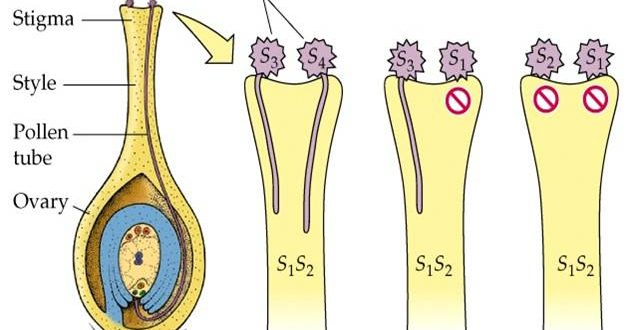
What will develop if fertilization does occur in a plant (between flowers or within the same flower)? Go into depth about its structure:
If fertilization happens, the ovule will develop into a seed.
Inside of the Seed, there is the:
Embryo (the baby plant that develops from the zygote, which is the fertilized egg and sperm when the pollen grain and the ovule came together)
-→ Inside the Embryo is the Radicle, which is the baby root, the Plumule, which is the baby shoot, and the Cotyledon, which is the food reserve inside the growing embryo.
Endosperm (inside the seed, not the embryo), that stores food reserves for the seed
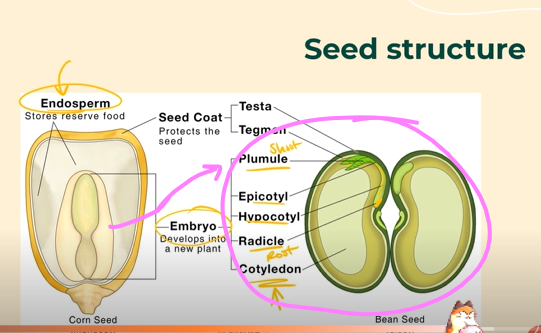
What is seed dispersal? Why does it happen?
Seed dispersal is moving or dispersing the seeds (not to be confused with pollen) away from the parent plant, so that they don’t end up competing for the same resources.
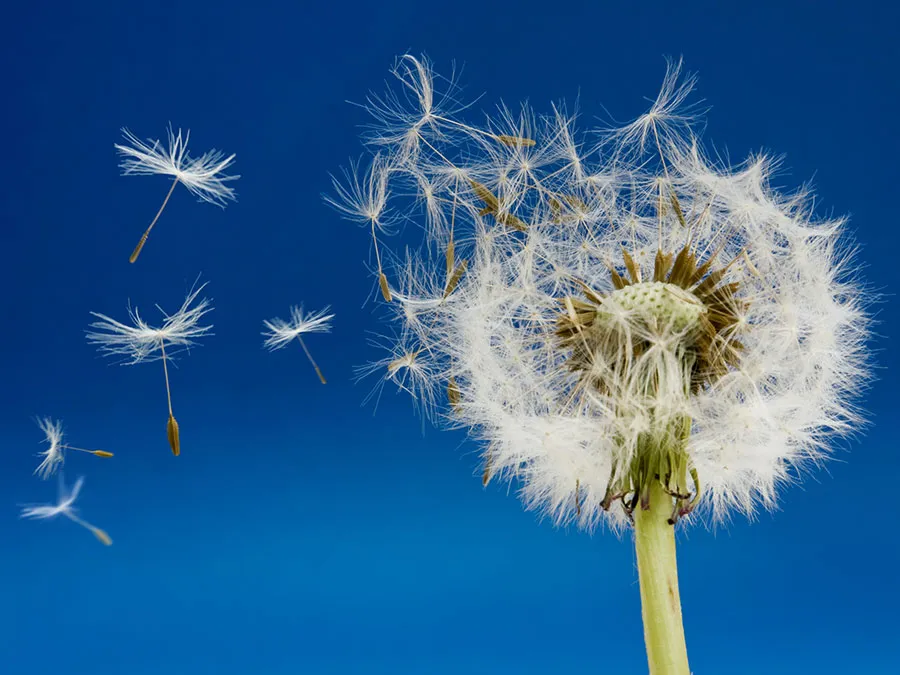
What are some different ways that seed dispersal can happen?
Seeds can be dispersed by wind, water, animals and birds.
Animals and birds tend to collect a lot of nuts and eat fruits with seeds in them, excreting the seeds in different areas, where they will grow. Other times, seeds will have hooks that can get stuck in animal fur and be dispersed when the animal moves away from the parent plant;
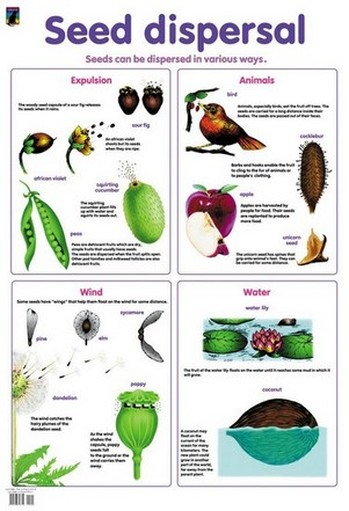
What is germination, and how is it different from fertilization?
Germination is the process of a plant growing out of a seed
Fertilization is the process of the sperm cell of a pollen grain fuses together with the egg cell of the ovule to form a diploid zygote (aka the seed)
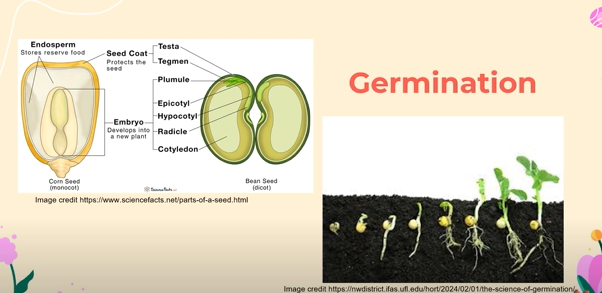
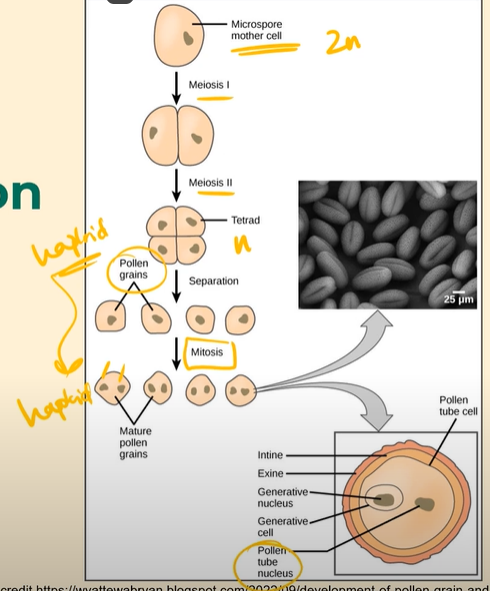
Does the pollen grain contain sperm cells when it is first created?
No, when the 4 haploid pollen grains are first created through meiosis, and then undergo mitosis to create two nuclei in each of the haploid cells, it contains no sperm!! It only contains two nuclei, each with a generative nucleus and a pollen grain nucleus.
It is only after the pollen tube starts to grow that the generative nucleus undergoes meiosis again, producing two sperm cells.

What factors are necessary for germination to happen?
In order for germination to happen, there needs to be:
1. A water source that is going to rehydrate the enzymes in the endosperm, which provides nutrition for the seed
2. It needs to take place the right temperature, to allow enzymes to function at their optimal temperature and be at their best
3. Oxygen for cellular respiration, because plants also have mitochondria that is going to make ATP
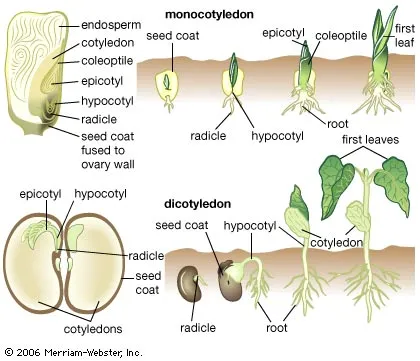
State how puberty begins in humans; What is the first thing that initiates puberty?
GnRH (Gonadotropin-Releasing Hormone) is first produced by the Hypothalamus of the brain.
The Hypothalamus sends GnRH to the anterior pituitary gland, and this stimulates the pituitary gland to produce FSH and LH, which will in turn, stimulate the ovaries and testes to produce testosterone, progesterone, eggs, and sperm.
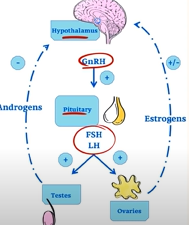
What does LH and FSH produce in males and females?
In Males:
Follicle Stimulating Hormone stimulates the growth of the testes
Luteinizing Hormones stimulates the Leydig cells in the Testes to secrete testosterone
During puberty, Testosterone leads to = pubic hair, enlargement of private parts, growth of the larynx and a deeper voice
In Females:
Follicle Stimulating Hormone stimulates multiple follicles in the ovaries to develop; Each of these follicles contains a growing egg or ovum, but only one of these follicles will actually go on to become a mature egg
Luteinizing Hormones causes the corpus luteum to secrete estrogen and progesterone
Estrogen (or Estradiol) leads to = the enlargement of the uterus, enlargement of breasts, and pubic hair. Progesterone prepares the mammary glands to produce milk.
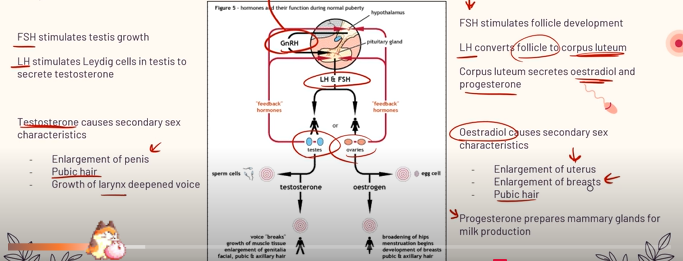
What is spermatogenesis? When does it start and end?
Spermatogenesis refers to the process of mature sperm developing!
Spermatogenesis starts at puberty, and continues on until death, so millions of sperm are produced
Where does Spermatogenesis take place? Be specific about where exactly it takes place
Spermatogenesis takes place where the male gametes are produced; in the testes.
Inside the testes, there are small tubes known as Seminiferous Tubules.
On the outside of each seminiferous tubules are Spermatogonia , undifferentiated cells that go on to produce sperm!
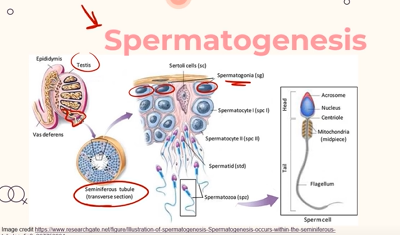
Describe the process of Spermatogenesis happening in Spermatogonia?
Spermatogonia are a type of stem cell found on the outside of Seminiferous Tubules, which are constantly going through Mitosis.
Because Spermatogonia are constantly dividing through Mitosis, there is a constant supply of them that can be differentiated into sperm cells.
Spermatogonia will eventually engage in Meiosis to produce gametes (sperm), as the end product.
Once Spermatogonia start undergoing Meiosis I, they are known as Spermatocytes I, then once they go through Meiosis II, they are known as Spermatocytes II, and by the time Meiosis is fully complete, they are called Spermatids.
Once the Spermatids are actually released out of the cells, they are now known as Sperm! And they travel to the Epididymis to be stored.
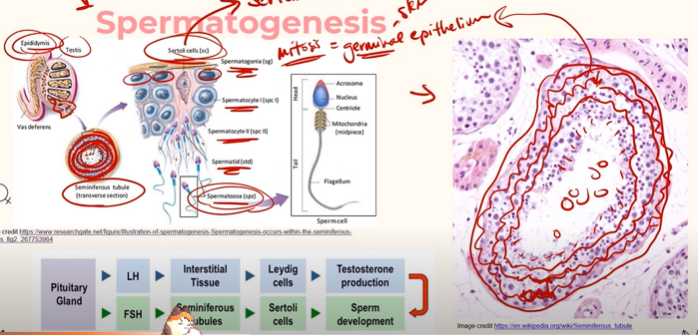
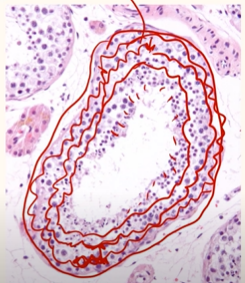
On this micrograph of a Seminiferous Tubule, can you identify which stages each Spermatogonia is at?
The layers on the very outside are the Diploid Spermatogonia (that have not yet gone through any Meiosis)
The second layer closest to the outside is the Haploid Spermatocytes I (that have gone through Meiosis I)
The third layer closest to the outside are the Haploid Spermatocytes II (that have gone through Meiosis II)
Lastly, the layer closest to the inside are the Spermatids, which are about to leave the Seminiferous tubule, and go on to leave the Seminiferous Tubule entirely to be Sperm stored in the Epididymus;
So the further away you are from the centre of the seminiferous tubule, the less mitosis you have gone through.
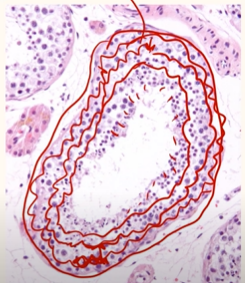
What are the Sertoli Cells and where are they located? What do the Leydig cells do and where are they located?
The Sertoli Cells are found Inside of the Seminiferous tubules of the testes, somewhere near the middle, and they help to nourish and develop the Sperm (after it has transformed from Spermatogonia to Spermatocytes and then to Spermatids through Meiosis)
Leydig cells are located close to the Seminiferous Tubules, and they secrete Testosterone. Leydig cells are actually the cells that get acted on by Luteinizing hormone, causing them to release testosterone.
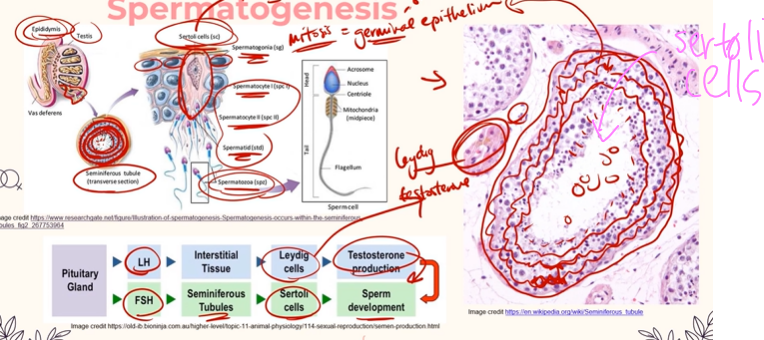
What are oogonia?
The undifferentiated diploid cells, found in the ovaries during early fetal development up until puberty, when they eventually go on to become egg cells.
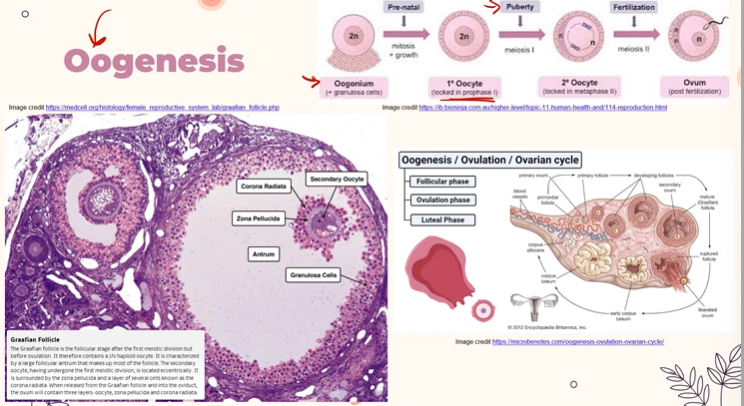
What is oogenesis? When does it start and end? Describe the steps of Oogenesis
Oogenesis refers to the production of egg cells.
It actually begins prior to birth, in the developing ovaries of a baby girl that is still in her mother’s uterus.
In the developing ovaries, the oogonia start to go through Meiosis, but once they reach Prophase I, they undergo Meiotic arrest, and this arrest continues on until they reach puberty.
Once puberty starts, Meiosis picks up again, because Follicle Stimulating Hormone stimulates multiple follicles to grow, but only one follicle actually goes on to produce an egg.
This allows the Oocyte to finish Meiosis I, where it is now known as a Secondary Oocyte.
As soon as the Secondary Oocyte starts Meiosis II, it pauses again, entering mitotic arrest just before it reaches Metaphase II.
Meiosis II will only complete if the egg is fertilized. If it is fertilized, it will complete Meiosis II and form a diploid zygote with the sperm.
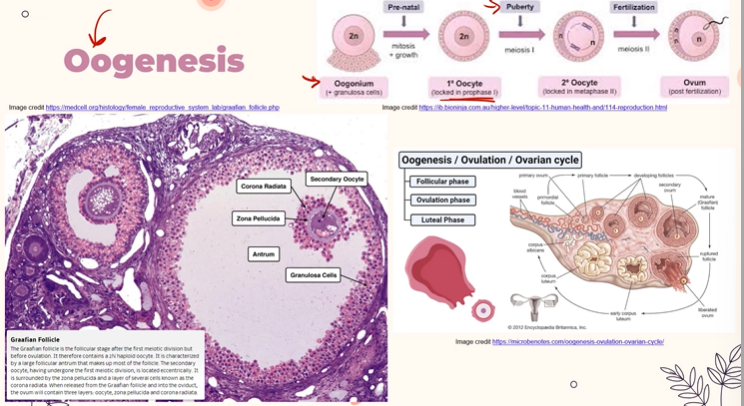
Compare and contrast Spermatogenesis and Oogenesis?
Spermatogenesis:
- Occurs entirely in the testes
-Cells are equally divided
-Four sperm cells are produced
-Sperm is smaller than spermatocytes
-Begins at puberty and is continuous, going on until death, but reduces with age.
Ooogenesis:
-Occurs mostly in the ovaries
-Cytoplasm is unequally divided, you end up with one giant egg cell, and another smaller cell called a polar body
-Begins in the fetus and is monthly until menopause
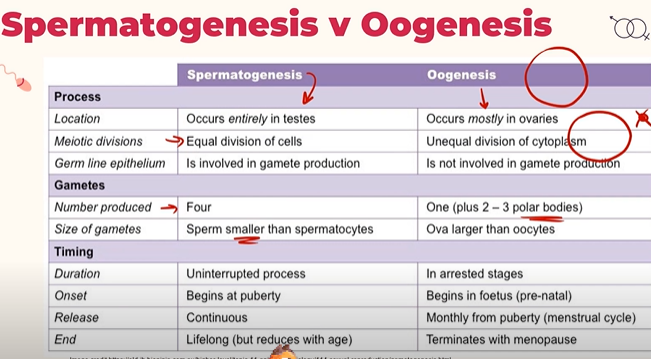
Can you describe the process of embryogenesis?
The zygote (sperm and egg cell fused together) continuously divides through mitosis to become the fetus.
Once the zygote has divided to have about 100 cells, it is now known as the Morula, a solid ball of cells;
When these cells migrate to the outer edge, they create a hollow ball of cells known as the Blastula.
Inside the Blastula is the inner cell mass, which are stem cells that go on to form the fetus.
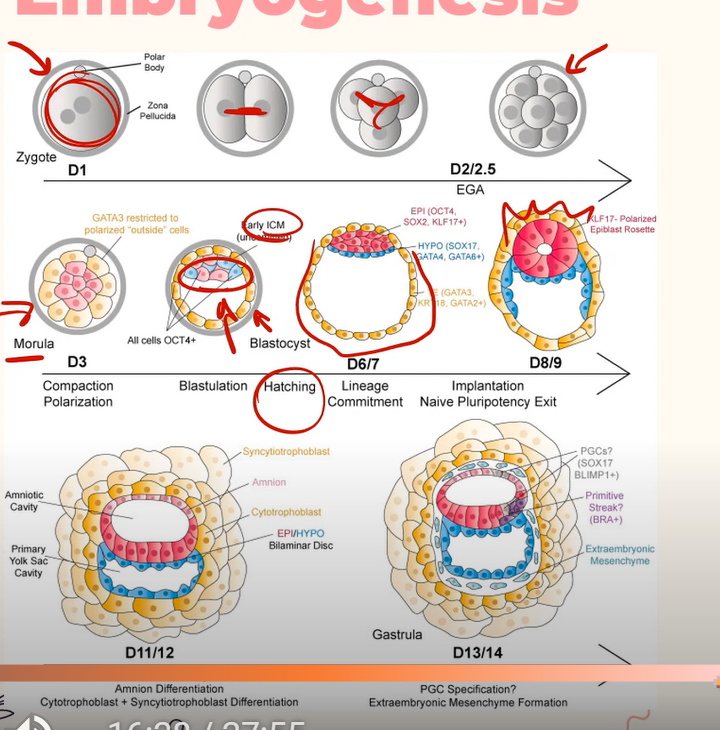
What do pregnancy tests detect?
Pregnancy tests detect the hormone human chorionic gonadotropin, which is ONLY secreted by the developing embryo.
Human chorionic gonadotropin is released by the embryo, and it targets the corpus luteum, causing it to secrete more progesterone to maintain the thickened uterine lining so that the embryo is protected inside the uterus.
And since some traces of HCG still remain in the urine. So if a woman with an embryo pees on a pregnancy test, the pregnancy test will detect the presence of HCG molecules in her urine.
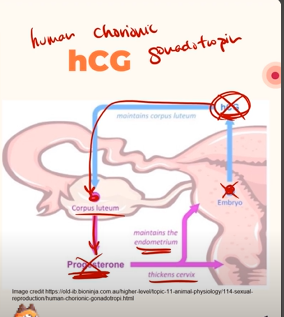
Briefly describe how a pregnancy test detects HCG?
Urine moves through the absorbent pad on the test stick. If HCG (Human Chorionic Gonadotropin) is present, it binds to specific antibodies in the test.
These antibodies travel along the test strip, carrying attached enzymes.
When antibodies reach the first test line, they attach to immobilized antibodies there.
The enzyme from the moving antibody causes a color change, indicating HCG presence (positive result).
If there is no HCG present, the antibodies will continue migrating down the stick, until they reach the “control” test line, that will bind to antibodies without HCG and won’t change color.
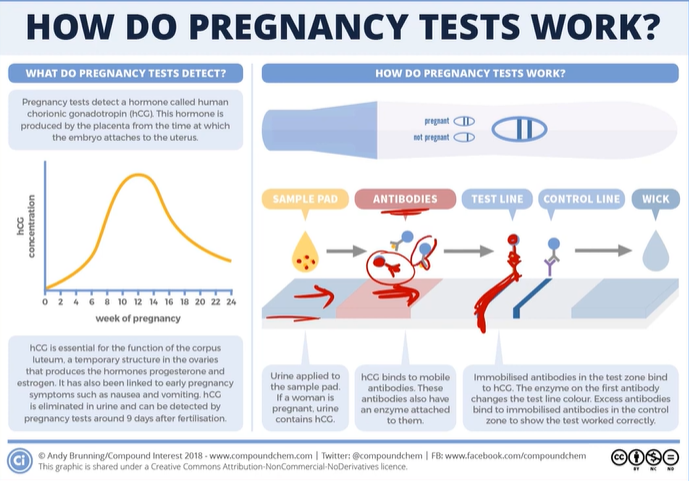
What is the placenta?
The placenta is a piece of tissue that forms in the uterus during pregnancy and is connected to the baby through the umbilical cord. It provides oxygen and nutrients to the baby.
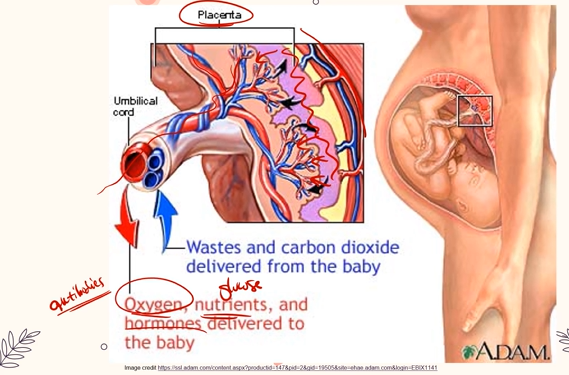
How come fetal blood doesn’t mix with the mother’s blood during pregnancy? What is exchanged between the mother’s blood and the fetus’ blood?
The placenta inside the uterus is semi-permeable, allowing oxygen, nutrients and hormones to be delivered to the baby without blood mixing.
The fetus sends blood containing waste, urea, and carbon dioxide, while in exchange, the mother diffuses oxygen, nutrients and hormones into the baby’s blood.
Also, the mother’s blood contains specific antibodies, so any disease that the mother is exposed to, she will be producing antibodies for; Which also end up in the baby’s blood, and give it immunity against that specific disease as well.
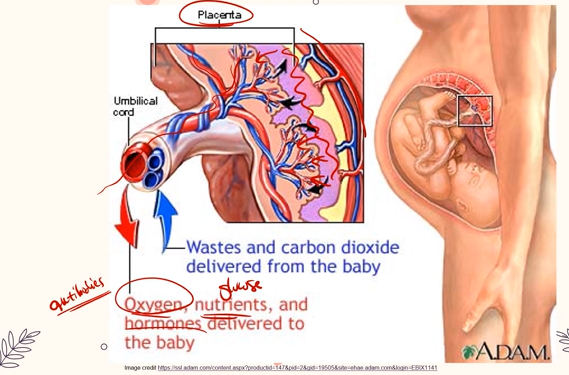
Is pregnancy a positive or negative feedback loop?
It is a positive feedback loop!
1. When pregnancy first starts, Human Chorionic Gonadotropin is being released by the growing embryo, which stimulates the ovaries to release progesterone to thicken the uterine lining.
2. As the embryo grows, more HCG is being produced, which increases progesterone levels even more!
3. Then the placenta (inside the uterus) starts producing increasing levels of estrogen and progesterone, maintaining the uterine lining for pregnancy while also preparing the body for childbirth.
4. Near birth, the baby’s movement stretches the uterine lining, which causes oxytocin to be released, and this stimulates the contraction of the uterus.
5. Stronger contractions increase oxytocin levels, pushing the baby out even further, until delivery happens.
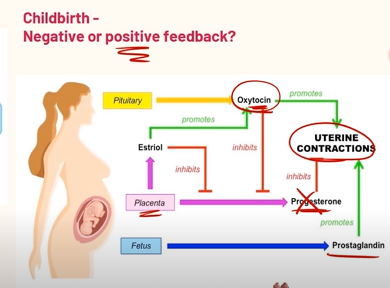
What happens to hormone levels in women during menopause? What are women prescribed after menopause and why?
During menopause, progesterone and estrogen levels drop significantly, and it causes a lot of discomfort; Because of this, they are often put on HRT (Hormone replacement therapy) to help alleviate those symptoms;
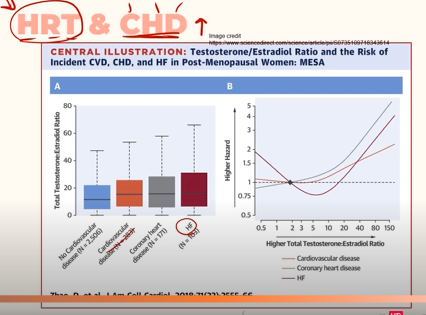
Is HRT (Hormone Replacement Therapy) connected to heart disease in any way?
Originally, studies showed that there was a correlation between lower risk of coronary heart disease and women on Hormone Replacement Therapy after menopause;
However, a lot of the people who were taking HRT were wealthy enough to afford it, and because of their higher socio-economic status, they could also afford to eat better food;
Later research actually showed that HRT was not the cause for a lower risk of heart disease, it was just that the women who were taking HRT could afford to eat healthier than those of a lower socio-economic status, and this was decreasing their risk of cardiovascular disease.
This shows that even though there may be a correlation between taking HRT and cardiovascular disease; This shows that the HRT was not causing lower incidences of heart disease, and that it was actually the lifestyle choices of the participants.
